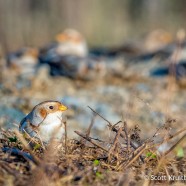Western Sandpiper (Calidris mauri)
Fall shorebirding can be very rewarding in a number of diverse habitats including farm fields, parking lots with pools of water, muddy pastures, grasslands, beaches, and rocky shorelines. Whether they are foraging, preening, or roosting there are always good chances to examine shorebirds for prolonged periods. That does not mean the task of identifying them will be easy! For every readily identifiable bird like the American Oystercatcher there seem to be a few difficult to discern species. The juvenile Western Sandpiper (Calidris mauri), as seen below and photographed in late August, can be...
Read MoreCedar Waxwing
Here is the always regal Cedar Waxwing (Bombycilla cedrorum) posing with a friend. There were actually several other pals nearby as well. June is a good time of year to find a small flocks of waxwings in and around your neighborhood while many other birds are paired off, quiet and defending territory. In fact, it is nearly always a good time to find these gregarious birds in flocks!
Read MoreSnow Bunting Row
These Snow Buntings are all lined up and ready to launch to the north soon as they continue to molt into a brighter, whiter snowy color every day. Birds are getting their feathers set for spring and to look their best when finding a mate. What does this arrangement on the roof look like to you? Caption it!
Read MoreCooper’s Hawk
I completely forgot to post these two photos of a young Cooper’s Hawk from last month, so here they are now. This individual was going after a Song Sparrow that had taken cover in a brush pile. It really seemed as if more accipiters remained in the Northeast during the extreme December record heat with more prey to find than usual in very cooperative weather conditions. What do you think is harder – hunting on a 60 degree sunny day with a light southerly breeze, or finding a meal when several inches of snow is falling in 20 degree temperatures with a bitter northerly flow? I...
Read MoreSnow Buntings
It is early enough in the avian wintering season that both the earth and the birds – in this case, Snow Buntings (Plectrophenax nivalis) – are brown. We do not have a solid snow cover yet, and it is amazing how well this plumage is designed to help them blend in to the ground. The Snow Bunting camouflage looks like brown grass and, somehow, a rocky, sandy and rough earth, with their wings showing off the darker pattern of what the tundra and short grasslands look like now. Notice how well these birds keep themselves just off the surface even while engaged in feeding, hiding their...
Read More








